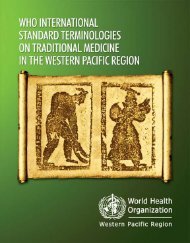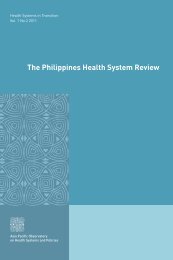Download pdf, 989kb - WHO Western Pacific Region - World Health ...
Download pdf, 989kb - WHO Western Pacific Region - World Health ...
Download pdf, 989kb - WHO Western Pacific Region - World Health ...
Create successful ePaper yourself
Turn your PDF publications into a flip-book with our unique Google optimized e-Paper software.
A Review of Literature and Projects 2005<br />
all the women interviewed reported that<br />
they had heard of family planning and<br />
were able to name at least three<br />
contraceptive methods. Adolescents<br />
aged 15-19 years knew less than young<br />
people aged 20-24 years. Another study<br />
in 1998 (see Table 2) showed that<br />
unmarried adolescents’ knowledge on<br />
various aspects of sexual and<br />
reproductive health was variable.<br />
Generally, girls knew more than boys<br />
about oral contraception<br />
(66.7% compared with 57.1%) but they<br />
were equal in terms of awareness on<br />
condoms. Both had a poor<br />
understanding of the whole reproductive<br />
process, especially pregnancy.<br />
Knowledge on HIV/AIDS was more<br />
prevalent than on STI, possibly due to<br />
the extensive media coverage of HIV/<br />
AIDS, which could also explain the<br />
higher prevalence of knowledge on<br />
condoms among both sexes.<br />
Table 3 illustrates that young people talk<br />
to mothers, teachers and friends about<br />
equally regarding puberty changes,<br />
pregnancy and contraception. However<br />
for male-female and sexual relationships,<br />
most of them talk with friends rather<br />
than mothers and teachers.<br />
Table 2: Percentage of respondents with correct responses on reproductive anatomy and physiology and who had<br />
heard of contraception, STI and HIV/AIDS, by gender<br />
Knowledge<br />
Male reproductive anatomy<br />
Female reproductive anatomy<br />
Reproductive physiology – foetal development<br />
Reproductive physiology – birth canal<br />
Pregnancy – through sexual intercourse<br />
Pregnancy – most likely at mid-cycle<br />
Contraception – condoms<br />
Contraception – pills<br />
STI – ever heard of<br />
AIDS - ever heard of<br />
HIV Transmission – random sex<br />
HIV Transmission – sharing needles<br />
Boys<br />
20.9<br />
25.3<br />
47.8<br />
36.0<br />
67.7<br />
57.1<br />
Sex<br />
85.3<br />
18.7<br />
65.3<br />
98.1<br />
95.6<br />
96.5<br />
Girls<br />
10.6<br />
23.3<br />
61.0<br />
44.6<br />
63.3<br />
66.7<br />
Source: National study on reproductive health and sexuality of adolescents, 1994/1995. NPFDB, 1998.<br />
25

















